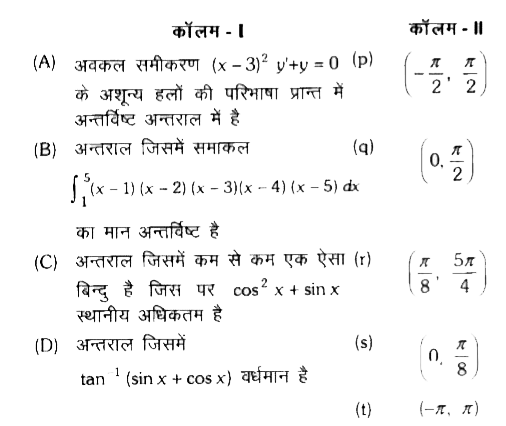If y=t4/3−3t−2/3, then dy/dt=
2t2+33t5/3
2t2+3t5/3
2(2t2+3)t5/3
2(2t2+3)3t5/3
The correct Answer is:D
Step by step video, text & image solution for If y=t^(4//3)-3t^(-2//3), then dy//dt= by Maths experts to help you in doubts & scoring excellent marks in Class 12 exams.
Topper's Solved these Questions
- BOOK - ERRORLESS HINDICHAPTER - अवकलन तथा अवकलज के अनुप्रयोगEXERCISE - MULTIPLE CHOICE QUESTIONS (एक बिन्दु पर अवकलज,मानक अवकलज)186videos
अवकलन तथा अवकलज के अनुप्रयोग
- BOOK - ERRORLESS HINDICHAPTER - अवकलन तथा अवकलज के अनुप्रयोगEXERCISE - MULTIPLE CHOICE QUESTIONS (अस्पष्ट फलनों का अवकलन,प्रचलिक व संयुक्त फलनों का अवकलन,लघुगणकीय अवकलन, अनन्त श्रेणियों के अवकलन )64videos
अवकलन तथा अवकलज के अनुप्रयोग
- BOOK - ERRORLESS HINDICHAPTER - अवकल समीकरण EXERCISE - JEE Advanced ( Matrix Match type questions )3videos
अवकल समीकरण
- BOOK - ERRORLESS HINDICHAPTER - केन्द्रीय प्रवृत्ति के मापEXERCISE - Jee Advanced (Reasoning )2videos
केन्द्रीय प्रवृत्ति के माप
Similar Questions
2f(x)=f'(x) एवं f(0)=3, तब f(2)=
05:10View Solutionमाना y,x2x−2xxcoty−1=0 से परिभाषित x का एक अस्पष्ट फलन है। तब y'(1) बराबर है
01:41View Solution 04:04View Solution
04:04View Solutionकथन - 1 : प्रथम n सम धन पूर्णांकों का प्रसरण n2−14 है।
कथन - 2 : प्रथम n धन पूर्णाको का योगफल n(n+1)2 और प्रथम n धन पूर्णांको के वर्गों का योगफल n(n+1)(2n+1)6 है।07:12View Solutionint_(0)^(2-sqrt(3))(t(3-t^(2)))/((1-3t^(2))(1+t^(2)))dt
02:27View SolutionIf y=sinx and x=3t then dydt will be
02:28View SolutionIf y=t3/3−t2−3t+1 then graph of y2 versus t will be, where y2=d2y/dt2
04:21View Solutiondydx ज्ञात कीजिये यदिx=3t1+3t2,y=3t31+3t3
01:17View SolutionIf u=3t4−5t3+2t2−18t+4, find dudt at t=1.
02:43View Solutionयदि x=3cos2t और y=2sin3t तो t=π4 पर dydx का मान कौन -सा होगा ?
04:18View SolutionIf x=cos−1(4t3−3t),y=tan−1(√1−t2t),thendydx=
03:24View Solutionx=2+t3,y=3t2 ,then the value dydx
02:01View SolutionIf y=t^(4//3)-3t^(-2//3) , so dy//dt=
03:49View SolutionIf x=3sint−sin(3t),y=3cost−cos3t, then find (dydx) at t=π3
View SolutionFind dy/dx if, x= cos−1 (4t3 - 3t), y= tan−1 sqrt (1- t2)}{t}
View Solution

